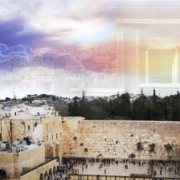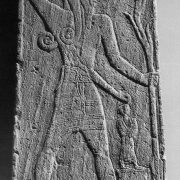The pagan gods of the ancient world did not humbly submit after the Resurrection. They’ve continued in their rebellion. Maybe they figure they’ve got nothing to lose. Like Inanna in the Epic of Gilgamesh, who tried to destroy Uruk because she’d been rejected by the hero of the tale, they’re willing to destroy everything rather than let the Messiah return to establish His throne over a world restored to its intended glory.
Their first response to the Resurrection was to inspire the Roman government and Jewish religious authorities to try to crush the growing body of believers. By the fourth century AD, when it was clear that Christianity was not going away despite the persecution from Rome, the Fallen tried a different tactic. The empire of the storm-god, called Jupiter in the west and Zeus in the east (and both just newer names for the old Canaanite storm-god Baal), legalized the faith with Constantine’s Edict of Milan in AD 313. Then in 380, Christianity became the official state religion when Theodosius issued the Edict of Thessalonica. Once the Church became a path to wealth and political power, there was no shortage of men and women who chose the clergy as a career—but it wasn’t because they were interested in saving sinners from the fires of hell.
Making Christianity the official religion of the Roman Empire was a brilliant move. Corruption in the Church persists to this day and it infects all denominations. But that has only weakened the body of believers, not killed it; as of this writing, the followers of Jesus Christ still outnumber all other religions on the earth.
But the Enemy employed another stratagem, one that’s exploited the Church’s weakness and the dilution of the gospel since the Renaissance and Enlightenment. Let’s begin by tracking the activity of the pagan gods in the years after the Resurrection.
A rough outline of the spiritual history of the ancient Near East shows that there were at least two transfers of power in the pantheon. First, a primordial god of heaven was overthrown by his son, who was considered “the” god between about 3000 and 2000 BC.
Around the time that the Amorites emerged as the dominant people group in the Near East, “the” god, variously called Enlil, Dagan, and El (later Kronos to the Greeks and Saturn to the Romans), was replaced as king of the pantheon by the storm-god—except in Akkad and Sumer, where the city-god of Babylon, Marduk, occupied that place of honor.
However, the personal god of the founding dynasty of Babylon was the moon-god. Some scholars now believe that the Sumerian god Amurru was actually an epithet of the lunar deity, “god of the Amurru (Amorite) land.” A text only translated within the last ten years of this writing reveals that the moon-god, Sîn, was believed to preside over the Mesopotamian divine council at least some of the time.
The nations led by these various deities fought with one another throughout the period of history covered by the Bible. Beginning around 1800 BC, the time of Abraham and Isaac, Marduk and his followers ruled Babylonia and Sumer, while Baal worshipers dominated western Mesopotamia (Canaan), followers of the sun-god controlled most of Egypt, and the moon-god was the chief deity of the nomadic tribes of the steppe and deserts of Syria and Arabia.
The fall of the Neo-Babylonian Empire to the Medes and Persians in 539 BC was probably another rebuke of the moon-god by Yahweh, who revealed to the prophet Isaiah, about a hundred and fifty years earlier, His plan to use Cyrus to return the Jewish exiles to Jerusalem. The rise of the Persian Empire and its devotion to Ahura Mazda, possibly another aspect of Marduk, may have been that entity’s play to go solo by rebelling against the other rebel gods. Of course, God used it for His purposes, to free His people from Babylon and humble the moon-god. (Belshazzar’s feast was during the annual fall festival for Sîn, which coincided with Sukkot—the Feast of Tabernacles.)
But Marduk’s shot at glory didn’t last long; within two centuries, people of the storm-god, first the Greeks and then the Romans, pushed the Persian Empire back to Mesopotamia. And with the rise of Islam in the seventh century AD, Zoroastrianism faded into the background.
This is admittedly speculation, an attempt to discern the history of the unseen realm from evidence in the natural. We have limited ability to see into the spirit realm. It does, however, fit recorded history. Before Christ, the Fallen fought amongst themselves as well as with God. After the Resurrection, it appears that they put aside some of their mutual distrust.
The conquest of Babylon by Cyrus apparently frustrated the plans of the moon-god to take over the empire of Nebuchadnezzar. But worship of the moon-god didn’t disappear with the Chaldean kingdom. The land south and southeast of Edom, around the north end of the Gulf of Aqaba, ancient Midian, was still moon-god territory. Tayma, the second home of Babylon’s last king, Nabonidus, was there, although it was no longer called Midian by his day.
Most of what scholars know about the pre-Islamic gods of northwestern Arabia, the area closest to the kingdom of Judah, comes from inscriptions found at Tayma and the other major oases in northern Arabia, Dumah and Dedan (Al-Ula). All three were strategically located along caravan routes connected to the spice trade between southern Arabia, Mesopotamia, and the Mediterranean world.
Getting a handle on the rest of the gods of Arabia between the fall of Babylon and the rise of Islam in the early seventh century AD is a challenge. Trying to pin down precise one-to-one correlations across times, places, and tribes is an exercise in frustration. For our purposes, the best approach is to draw some general conclusions.
It appears there were several deities that were most prominent throughout Arabia, although they were worshiped under different names. The other oases in northern Arabia, Dedan and Dumah, worshiped a pantheon headed by Attarshamain, the “queen of heaven.” The name of the goddess is a composite: Attar + shamain (“Attar of the skies”); in other words, she was the Canaanite Astarte, Babylonian Ishtar, and the ancient Sumerian goddess Inanna by a slightly different name.
Dedan, seventy miles southwest of Tayma, was the center of a tribal confederacy that included the powerful Qedarites, a tribe named for Kedar, son of Ishmael. Attarshamain, represented by the planet Venus, was part of an astral triad with Nuhā and Rudāʾu, the sun-god and moon-god.
In southern Arabia, modern-day Yemen and Oman, over one hundred deities have been attested but only one was worshiped throughout the region—the war-god Athtar, who was the male aspect of the dualistic Canaanite god/dess Astarte/Attar. Other important south Arabian gods included the moon-god Syn or Sayin (a variant of Sîn); Wadd, another name for the moon-god; the sun-goddess Shams (variant of Shamash, the sun-god); ʿAmm (“paternal uncle”), a god whose name suggests ancestor worship; and a trio of goddesses named al-Lāt (“the goddess”), al-ʿUzzā (“the most powerful”), and Manāt. Scholars are divided on the origins of those three, other than to note that they appear to have been brought to Arabia in the second century BC.
We’re painting with a broad brush here. To draw a general conclusion: As we look at the religions of Arabia in the eleven hundred years or so between the fall of Babylon in 539 BC and the rise of Islam in the 620s AD, the deities who survived were the old Mesopotamian astral triad—sun, moon, and Venus—and the male aspect of Astarte, the war-god Athtar. To add to the confusion, Astarte and Athtar may have been worshiped as separate entities as early as the ninth century BC, with the male war-god identity linked to Moab’s national deity, the war-god Chemosh.
But there is one more conclusion we can draw that seems solidly grounded in history: While the worship of Jesus Christ spread widely in the centuries after the Resurrection, reaching as far east as China and as far west as Britain, there is one land frequently mentioned in the Bible where Christianity never gained a firm foothold—Arabia.
Extrapolating from that bit of history, we offer this theory: The gods of the ancient world, stunned and alarmed by the Resurrection, withdrew, like the unclean spirit of Matthew 12:43–45, to a waterless place—Arabia.
And there they planned their counterstrike.

Derek Gilbert Bio
Derek P. Gilbert hosts SkyWatchTV, a Christian television program that airs on several national networks, the long-running interview podcast A View from the Bunker, and co-hosts SciFriday, a weekly television program that analyzes science news with his wife, author Sharon K. Gilbert.
Before joining SkyWatchTV in 2015, his secular broadcasting career spanned more than 25 years with stops at radio stations in Philadelphia, Saint Louis, Little Rock, and suburban Chicago.
Derek is a Christian, a husband and a father. He’s been a regular speaker at Bible prophecy conferences in recent years. Derek’s most recent book is The Great Inception: Satan’s PSYOPs from Eden to Armageddon. He has also published the novels The God Conspiracy and Iron Dragons, and he’s a contributing author to the nonfiction anthologies God’s Ghostbusters, Blood on the Altar, I Predict: What 12 Global Experts Believe You Will See by 2025, and When Once We Were a Nation.












Leave a Reply
Want to join the discussion?Feel free to contribute!